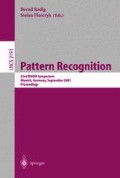Abstract
From the task of automatically reconstructing real world scenes using range images, the problem of planning the image acquisition arises. Although solutions for small objects in known environments are already available, these approaches lack scalability to large scenes and to a high number of degrees of freedom. In this paper, we present a new planning algorithm for initially unknown, large indoor environments. Using a surface representation of seen and unseen parts of the environment, we propose a method based on the analysis of occlusions. In addition to previous approaches, we take into account both a quality criterion and the cost of the next acquisition. Results are shown for two large indoor scenes — an artificial scene and a real world room — with numerous self occlusions.
The work presented here was done while Konrad Klein was with the EC-Joint Research Centre, funded by the European Commission’s TMR network “CAMERA”, contract number ERBFM-RXCT970127.
Access this chapter
Tax calculation will be finalised at checkout
Purchases are for personal use only
Preview
Unable to display preview. Download preview PDF.
References
M.-E. Algorri and F. Schmitt. Mesh Simplification. In Eurographics Proceedings, volume 15, 1996.
C. I. Conolly. The determination of next best views. In International Conference on Robotics and Automation, pages 432–435. ICRA-85, 1985.
Konrad Klein and Vítor Sequeira. The view-cube: An efficient method of view planning for 3d modelling from range data. In Proceedings 5th IEEE Workshop on Applications of Computer Vision (WACV 2000), pages 186–191, 2000.
Jasna Maver and Ruzena Bajcsy. Occlusions as a guide for planning the next view. IEEE Trans. Pattern Analysis and Machine Intelligence, 15(5):417–433, May 1993.
Richard Pito. A sensor based solution to the next best view problem. In Int. Conference on Pattern Recognition, pages 941–945, Vienna, Austria, August 1996.
Michael K. Reed and Peter K. Allen. Constraint-based sensor planning for scene modeling. IEEE Trans. Pattern Analysis and Machine Intelligence, 22(12):1460–1467, December 2000.
D. R. Roberts and A. D. Marshall. Viewpoint selection for complete surface coverage of three dimensional objects. In British Machine Vision Conference, pages 740–750, 1998.
Vítor Sequeira, João G. M. Gonçalves, and M. Isabel Ribeiro. Active view selection for efficient 3d scene reconstruction. In Proc. ICPR’96-13th International Conference on Pattern Recognition, pages 815–819, Vienna, Austria, 1996.
Vítor Sequeira, Kia Ng, Erik Wolfart, João G. M. Gonçalves, and David Hogg. Automated reconstruction of 3d models from real world environments. ISPRS Journal of Photogrammetry and Remote Sensing, (54):1–22, 1999.
Author information
Authors and Affiliations
Editor information
Editors and Affiliations
Rights and permissions
Copyright information
© 2001 Springer-Verlag Berlin Heidelberg
About this paper
Cite this paper
Klein, K., Sequeira, V. (2001). View Planning for Unknown Indoor Scenes Based on a Cost Benefit Analysis. In: Radig, B., Florczyk, S. (eds) Pattern Recognition. DAGM 2001. Lecture Notes in Computer Science, vol 2191. Springer, Berlin, Heidelberg. https://doi.org/10.1007/3-540-45404-7_42
Download citation
DOI: https://doi.org/10.1007/3-540-45404-7_42
Published:
Publisher Name: Springer, Berlin, Heidelberg
Print ISBN: 978-3-540-42596-0
Online ISBN: 978-3-540-45404-5
eBook Packages: Springer Book Archive

